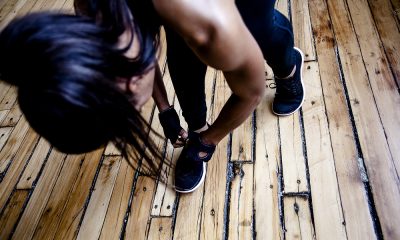How Ruth Bader Ginsburg Became Notorious and What We Do Now
How do you try to describe someone as legendary as Ruth Bader Ginsburg?
I, like many other American women, are feeling this loss deeply.
While obviously, I didn’t know her personally; I feel like I have lost someone very dear.
Ruth Bader Ginsburg was much more than a lawyer and a judge.
She was an icon, a symbol, a beacon of hope, and a guardian for those that needed her help.
On March 15, 1933, an ordinary day in Brooklyn, NY, little Joan Ruth Bader was born, and the world welcomed a force of nature.
Her childhood nickname of “Kiki” was given to her because she always kicked her little legs around as an infant.
According to Mathew Burke, “She was determined to raise a ruckus since before she could walk.
As you can imagine, when this toddler started growing up, she became even more of a handful.”
Have you seen these Ruth Bader Ginsburg quotes and sayings?
Ruth Bader Ginsburg’s beginnings
Every parent looks at the behavior of our young children and hopes it will help them accomplish extraordinary things, be pioneers of a cause, or at the very least, be happy and live a meaningful life.
I wonder what dreams her parents had for her?
Ruth’s mom was born in the US, and her father immigrated here from Russia.
Her mom helped her father with the family fur trading business, but never had a career of her own.
Yet, she was a fervent supporter of Ruth’s academic and professional ambitions.
Celia, Ruth’s mom, suffered from poor health her whole life, passing away from cancer the day before Ruth graduated from high school.
As a mother myself, I know how proud Celia must have been of her baby.
Ruth’s accomplishments didn’t stop at graduating from high school.
She went on to Cornell University and then Harvard Law, where she was one of nine female students.
Women practicing law was such a novel idea that the law dean asked all the women to justify taking places at the school which men could occupy.
Her time here offers us a glimpse into the person who Ruth was.
Who was Ruth Bader Ginsburg as a person?
Ruth and her husband met because of a blind date at Cornell, and after graduation, he would go to Harvard Law School.
Ruth joined him 14 months after their daughter was born.
Not only was she a woman, but she was also a young mother.
However, law school and motherhood wasn’t the only challenge that RBG would face.
Her husband was diagnosed with testicular cancer while the pair were at Harvard.
Ruth made sure she attended not only her classes but his too.
She typed all his papers for him, besides taking care of him and their daughter.
All her hard work earned her a spot on the Harvard Law Review.
Upon her husband’s graduation, the family moved to NY for his job, and Ruth transferred to Columbia for her last year; she also sat on the law review.
No other student had ever sat on both reviews, but Ruth was just beginning to shatter the precedents.
Hardship, fear, and condemnation did not deter Ruth Bader Ginsburg.
She seemed to thrive on it and still was a loving and caring wife and mother.
Despite graduating with a phenomenal record, Ruth found it hard to become a practicing lawyer.
She was a woman, and this was a deterrent to the 12 law firms that interviewed her.
Her Harvard Law professor’s recommendation didn’t even get her an interview with Supreme Court Justice Felix Frankfurter.
She ruthlessly persisted, because that is who RBG was.
RBG The Lawyer
“I tell law students… if you are going to be a lawyer and just practice your profession, you have a skill—very much like a plumber.
But if you want to be a true professional, you will do something outside yourself… something that makes life a little better for people less fortunate than you.”
Her legal career began thanks to one of her Columbia law professors.
He convinced Judge Edmund Palmieri to offer Ruth a clerkship.
She would be his law clerk from 1959 to 1961.
After that, she became an associate director of the Columbia Law School’s Project on International Procedure.
She studied Swedish civil procedure, and eventually co-writing Civil Procedure in Sweden, with Anders Bruzelius.
Being a woman affected Ruth’s professional life in many ways, the first being the tough time she had finding work, despite graduating in a tie for first in her class.
After the Columbia project, they hired her as an assistant professor at Rutgers.
The Dean requested that she accept a low salary since her husband Martin was a well-paid tax attorney.
During her pregnancy with her son James, she wore loose-fitting clothes and remained quiet about her condition for fear that they would not renew her contract.
It doesn’t surprise me that Ruth Bader Ginsburg got involved professionally in gender equality issues.
In 1971 she published two law review articles on women’s liberation and taught a seminar on gender discrimination.
She partnered with the ACLU and drafted two federal cases.
The first was about a tax code provision that denied single men with families a tax deduction.
Supreme Court case Reed v. Reed, disputing an Idaho law that favored men as administrators of the estates of people who died without a will, was struck down on the equal protection clause.
In 1972, she became founding counsel of the ACLU’s Women’s Rights Project and wrote another book.
This time it was a law school casebook.
In 1972, Ruth broke another precedent by becoming the first female faculty member to earn tenure at Columbia Law School.
She would write many more law review articles and Supreme Court drafts during this time.
Throughout the 70s, Ruth argued six cases before the nation’s highest court and won five of them.
The 80s would welcome her first federal appointment.
President Jimmy Carter appointed her to the US Court of Appeals, where she served with conservative judges Robert Bork and Antonin Scalia.
On June 14, 1993, President Bill Clinton nominated her to replace Justice Byron White.
On August 3, she became the second woman appointed to the Supreme Court.
She was a vocal proponent of women’s rights cases like:
- Gonzales v. Carhart, which she argued, “cannot be understood as anything other than an effort to chip away at a right [the right of women to choose to have an abortion] declared again and again by this Court.”
- Ledbetter v. Goodyear Tire, a case about a woman’s right to bring civil suits against employers over unfair wage practices
- Shelby County v. Holder, where the conservative majority struck down Section 4 of the Voting Rights Act
She has affected women’s lives in so many ways, and it necessary to acknowledge her value as a person, a lawyer, and a woman.
Now that she is gone, many of us are asking, “who will be our champion?”
Or “What comes next?”
How to be Ruthless from now on
When Ruth Bader Ginsburg was asked how she wanted to be remembered, she said, “Someone who used whatever talent she had to do her work to the very best of her ability.
And to help repair tears in her society, to make things a little better through the use of whatever ability she has.
To do something, as my colleague David Souter would say, outside myself.
‘Cause I’ve gotten much more satisfaction for the things that I’ve done for which I was not paid.”
Now that she has passed away, America will need to carry on.
We can do many things to honor her memory, like teach our daughters who she was and speak her name often.
I have seen so many RBG shirts, wall art, and other things, and I want them all.
However, nothing warms my heart more than little girls dressed as RBG for Halloween this year.
We should honor her wish to not fill her seat until after the election, but that is beyond my control.
However, you can send your Senators a letter asking them to hold the vote by texting RBG to 50409.
I did it and received a reply from my state’s senators within a few hours.
We can honor her by continuing to speak up for those and fight the fight.
Or ‘get into good trouble’ as John Lewis would have said.
We can do both things by voting in representatives that will make laws she wouldn’t find alarming.
Ruth once said, “When I’m sometimes asked ‘When will there be enough [women on the Supreme Court]?’ and I say ‘When there are nine,’ people are shocked.
But there’d been nine men, and nobody’s ever raised a question about that.”
I think back to that moment where Ruth, one of nine female law students, had to justify her taking away a seat from a man, and I hope she felt vindicated when they swore her in on a court of nine.
I will wait, not so patiently, for the day America is a beautiful place to live again.
I will raise my glass and toast ‘The Notorious RBG’ the day there are nine.











